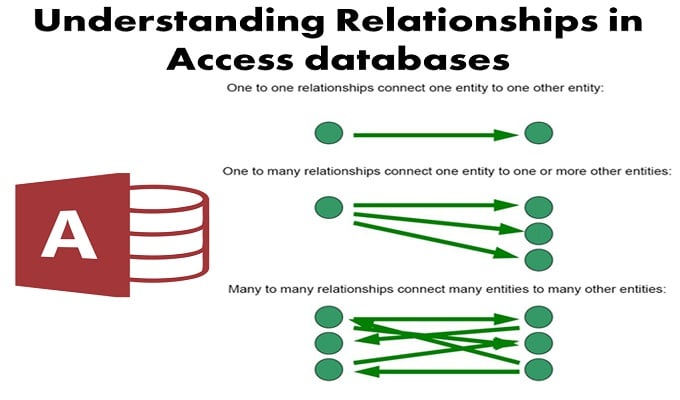In this article, we will understand the relationship of different functions, and relating data in Access.
Access uses database normalization to organize table (relations), and columns (attributes) of a relational database in order to minimize data redundancy. Normalization is the process, which splits the data across different tables which helps in improving overall performance, longevity, and integrity of resources within an organization.
- Normalization is a database process of organizing data.
- This comprises of table creation, Table relationship establishment between rules designed for data protection and to promote database flexibility, by eliminating inconsistent dependency and redundancy.
Defining Relationships

Let’s take a look at these relationships.
1. One-to-Many Relationships
This is one of the common forms of relationship, in which a row from table X can have one or more similar rows in Table Y. But Table Y is allowed to have only one row that can match Table X. Every big organization around the world is known for using this method to prompt data accessibility between tables.
For instance, a shopper has a Customer and Order tables, with a one-to-many relationship; every customer is allowed to make as many orders as he wants, but each order id for a product can only have one customer.
2. Many-to-Many Relationship
In this type of relationship, both table X and Y can have multiple matching rows in each other’s database. Users can create this kind of relationship by creating giving a definition to a third table. This third table is called Junction Table, whose primary key comprises of the foreign key from both table X and table Y.
For example, a cookies table and Customer table share a many-to-many relationship, which is further defined by a one-to-many relationship consisting of both these tables and a Junction Table ‘Order’.
3. One-to-One Relationship
In most one-to-one relationships, a row of Table X can only have a single similar row from table Y, and Table Y can also have one similar row from Table X. This form of relationship is created when both related columns in the Tables consist of a unique constraint or a primary key.
This is one of the rare relationships amongst these three, as this form of relationship restricts information from traveling through another table, as it is limited to just one table.
One-to-one Relationship is used in conditions like:
- If the user wants to divide the table into multiple columns.
- For isolating parts of a table into different sections to make the data more secure.
- For storing short-lived data that is prone to get deleted with the deletion of the table.
- For storing information that applies to only a subset information from the main table
For all its sophistication, MS Access database still remains vulnerable to file corruption so it is very important to keep an accdb repair tool on hand. Users can avoid complications like data loss by choosing to procure a specialized recovery application.
Author Introduction:
Vivian Stevens is a data recovery expert in DataNumen, Inc., which is the world leader in data recovery technologies, including sql recovery and excel recovery software products. For more information visit www.datanumen.com